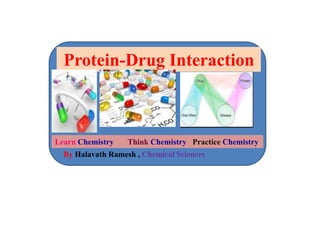
Protein-Drug Interaction
- 1. Protein-Drug Interaction Learn Chemistry Think Chemistry Practice Chemistry By Halavath Ramesh , Chemical Sciences
- 2. Introduction The study of protein-drug interaction is of pivotal importance to understand the structural feature essential for ligand affinity. Binding between bioactive compounds and proteins plays a pivotal role in many therapeutic or preventive approaches. In the first place, in fact most drugs carry out their action through the direct modulation of the activity of protein and protein complexes. In the first place, in fact most drugs carry out their action through the direct modulation of the activity of proteins and protein complexes.
- 3. Moreover, several proteins regulates the transport and distribution of drugs with in organisms, tissues and cells. Therefore , a detailed understanding of the molecular mechanisms underlying the formation of drug/protein complexes and of the variation induced by this interaction on proteins activity and interactome is of utmost importance's for drug discovery, pharmacology, pharmacotoxicology and medicinal chemistry studies. Drugs diffuse across a cell membrane from a region of high concentration (eg. Gastrointestinal fluids) to one of low concentration (eg.blood). Diffusion rate is directly proportional to the gradient but also depends on the molecules lipids solubility , size, degree of ionization and the area of absorptive surface.
- 4. The binding of drugs with proteins in the blood stream is an important process in determining the eventual activity and fate of such drugs once they have entered the circulation. These interaction in turn, help control the distribution, rate of excretion, and toxicity of drugs in the body. Aspirin highly protein bound . Major metabolite, salicylate, highly protein bound (80% to 90 %). Aspirin is one of a group of drugs called Non-Steroidal anti- inflammatory drugs.(NSAID) It’s widely to relieve mild to moderate pain and inflammation.
- 5. Three type of drugs interactions 1. Drug-Drug interactions 2. Drug-Food interaction 3. Drug- Disease interaction Drug-protein binding may vary from 0 % ( eg, Lithium) to 99 % ( eg. Ketorolac) and it is only the bound drug (free drug) that is pharmacologically active. Some drugs are capable of binding to blood cells, but the predominant binding is to serum proteins, primarily albumin. The fraction of free versus bound drug in serum is influenced by endogenous and exogenous compounds that complete with the drug for binding to albumin or other proteins. Protein-Drug interaction is a physical attraction between protein and drug molecule which greatly influences the action of drugs.
- 6. Type of drug interactions : There are several different types of drug interactions to be aware of. Let’s explore each one a little further. 1. Drug-Drug : A drug- drug interaction is when there’s an interaction between two or more prescription drugs. One example is the interaction between warfarin (Coumadin), an anticoagulant (blood thinner) , and fluconazole ( Diflucan),an antifungal medications. Taking these two drugs together can lead to a potentially dangerous increase in bleeding. 2. Drug-food : This happens when food or beverage intake alters a drug’s effect. For example, some stains (used to treat high cholestrol) can interact with grapefruit juice. If a person who takes one of these statins drinks a lot of grapefruit juice, too much of the drug may stay in their body, increasing their risk for liver damage or kidney failure. Another potential outcome of the statin- grapefruit juice interaction is rhabdomyolysis. This is when skeletal muscle breaks down, releasing a protein called myoglobin into the blood. Myoglobin can go on to damage the kidneys.
- 7. 3. Drug-nonprescription treatment: This is a reaction between a drug and a nonprescription treatment. These include over-the-counter (OTC) medications, herbs, vitamins, or supplements. Over-the-counter(OTC) drugs are medicines sold directly to a consumer without a requirement for a prescription from a healthcare professional as opposed to prescription drugs, which may be supplied only to consumers possessing a valid prescription. 4. Drug-Disease interaction: Drug-Disease condition interactions may occur when an existing medical condition makes certain drugs potentially harmful. Drug-disease interactions are situations where the pharmacotherapy used to treat a disease causes worsening of another disease in a patient.
- 8. Protein-Drugs interaction is a physical attraction between protein and drug molecules which greatly influences the action of drugs. In order for a drug to act upon a receptor or be metabolized by an enzyme, it must first be bound to receptor protein or enzyme. The study of drug interaction with receptor protein is extremely difficult and for the reason model systems with serum proteins are utilized. Another type of strong bond is called the coordinate covalent bond and is found in the formation of complexes which are formed by several atoms such as N, S, or O clustered about a central metal atom. Don’t drink grapefruit juice if you’re taking any of these medications, unless advised to by your doctor.
- 9. Protein –Drug interaction studies characterization by following method 1. NMR Spectroscopy 2. UV-vis Spectroscopy 3. Circular Dichroism (CD) spectroscopy 4. Fourier transform infrared spectroscopy 5. Steady-state fluorescence spectroscopy 6. Saturation transfer difference (STD-NMR) Spectroscopy 7. Molecular Docking Study 8. MD simulation –root mean square deviations(RMSD) 9. NMR based screening : diffusion NOE pumping 10. Pulse field gradient NMR 11. Time-resolve fluorescence life time spectroscopy(time-correlated single photon counting- TCSPC) 12. Isothermal titration calorimetric ( ITC) 13. Dynamic light scattering (DLS) 14. Differential scanning calorimetry (DSC) 15. Biological antimicrobial activity 16. Forster resonance energy transfer(FRET)